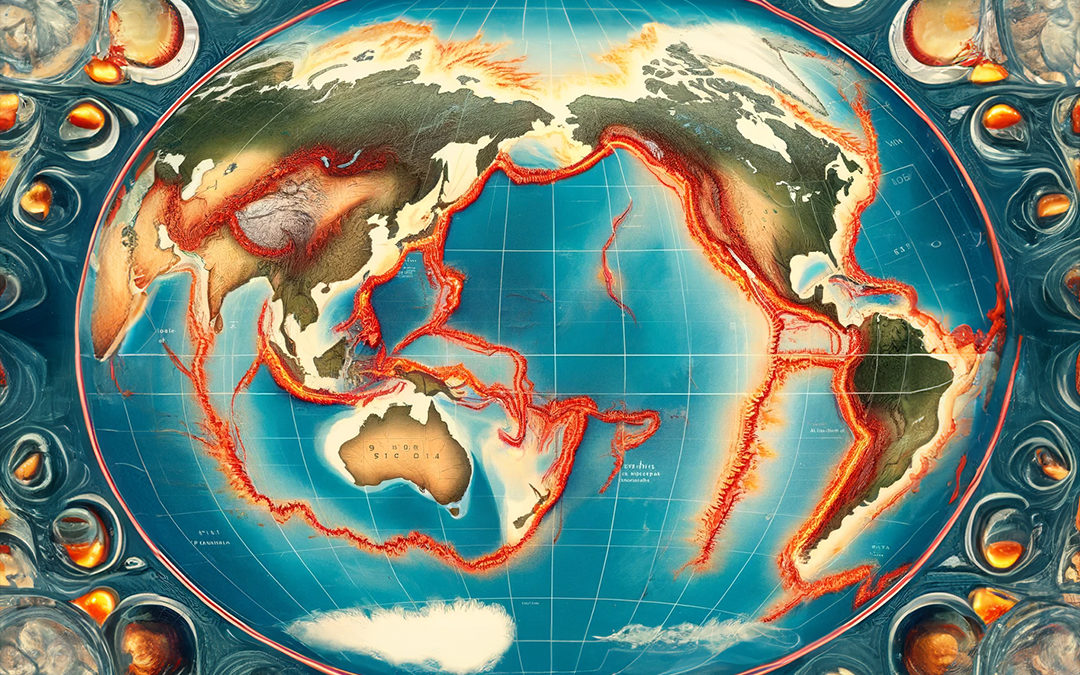The Taiwanese are no strangers to earthquakes and the latest on April 3rd 2024 was a doozy. Measuring 7.4 on the Richter scale, it took lives, leveled buildings, crumbled infrastructure, and wreaked havoc on the landscape. The area continues to rattle with sizeable quakes recorded in Japan and the Northern Mariana Islands—all of which sit on the infamous Pacific Ring of Fire where 90 percent of the world’s earthquakes occur. In addition, the Ring of Fire houses about 75 percent of the world’s active and dormant volcanoes.
The Ring of Fire encircles the Pacific Ocean, and is the result of tectonic plate movements. It covers an area from New Zealand, along the eastern edge of Asia, across the Aleutians, and down the coasts of North and South America.
The mythical continent of Mu, purportedly located in the Pacific Ocean, is said to have sunk into the sea thousands of years ago. Theories of Mu’s existence often draw parallels with Atlantis, suggesting it was a highly advanced civilization that met its demise through cataclysmic geological events. Some proponents of this theory have speculated that the Ring of Fire’s intense seismic and volcanic activity could be linked to the sinking of Mu, proposing that the continent’s disappearance was the result of massive earthquakes or volcanic eruptions.
For those of us that believe that Mu and Atlantis existed, the recent seismic events, seem like a repeat performance of pre-history. As mentioned in prior posts, we wonder if humanity is once again at the same crossroads as it was during the last destruction. Does the earth literally react to our energies? Are seismic and volcanic activities simply a matter of cause and effect? —mankind’s karma? Will wars, greed, misused technology, pollution, and the blatant disrespect of Mother Earth once again throw the world and its inhabitants into chaos and destruction? Unless we change our ways, we think so.
The Edgar Cayce readings contain evidence that we reincarnate through many lifetimes, and often with the same souls with which we have karmic ties. On the same note, many religions teach that there are cycles that repeat, and that God (or however you perceive the divine) because of love, continues to offer us the opportunity to spiritually progress. We appear to be at the same crucial point in our development as when the last cataclysmic events occurred. Just saying.
So, let’s get back to science. The study of the Ring of Fire involves a multidisciplinary approach, leveraging a variety of scientific methods and technologies to understand the complex geological processes at play. Key among these methods are:
1. Seismology: Seismologists use seismographs to detect and measure the vibrations caused by earthquakes, which are prevalent in the Ring of Fire. This data helps in mapping fault lines and understanding the dynamics of tectonic plate movements. Analysis of seismic waves allows scientists to pinpoint the location, depth, and magnitude of earthquakes, offering insights into the stress points within the Earth’s crust.
2. Volcanology: Researchers study volcanoes through direct observation, satellite imagery, and by monitoring volcanic gases, ash emissions, and lava flows. Instruments like spectrometers can measure gas compositions, while thermal cameras and satellites monitor heat signatures from erupting or potentially active volcanoes. This information is crucial for predicting volcanic eruptions and assessing their potential impact.
3. Plate Tectonics Study: Scientists use GPS and satellite data to track the movement of tectonic plates. This geodetic monitoring provides precise measurements of how plates are shifting, which is vital for understanding the mechanics of subduction zones and the forces driving volcanic and seismic activity.
4. Oceanography: In the marine regions of the Ring of Fire, oceanographers study the seafloor through sonar mapping and submersible vehicles. This exploration reveals underwater volcanoes, hydrothermal vents, and deep-sea trenches, contributing to our knowledge of the oceanic components of tectonic plate boundaries.
5. Geochronology and Paleomagnetism: To understand the historical activity within the Ring of Fire, scientists date rocks through radiometric dating techniques. Additionally, the study of paleomagnetism, which examines the magnetic properties of rocks, provides clues about past movements of the Earth’s plates and the history of magnetic field reversals.
6. Remote Sensing and Satellite Imagery: Satellites equipped with various sensors provide a broad, comprehensive view of the Earth’s surface, including the Ring of Fire. They offer valuable data on topography, thermal anomalies indicating volcanic activity, and changes in the landscape due to seismic events.
7. Computational Modeling: With the data gathered from these various methods, scientists use computer models to simulate geological processes, such as magma movement beneath volcanoes or the stress accumulation along fault lines. These models are invaluable for predicting future activity and for testing hypotheses about the underlying causes of volcanic and seismic events.
By integrating these diverse scientific methods, researchers can piece together a comprehensive picture of the Ring of Fire’s dynamic geological processes. This interdisciplinary approach is essential for advancing our understanding of Earth’s geology and for mitigating the risks associated with living in one of the planet’s most active geological zones.
The bottom line is that remnants of the lost continent of Mu can be found in the form of microcontinents or submerged landmasses in the Pacific. This leads to an intriguing question: Could the geological tumult within the Ring of Fire be responsible for the disappearance of Mu? This hypothesis hinges on the idea that the intense seismic and volcanic activity characteristic of the Ring of Fire could have led to the submergence or fragmentation of this ancient landmass. To explore this connection, we must evaluate geological evidence, such as the distribution of seismic activity, the history of volcanic eruptions, and the patterns of tectonic plate movement in the Pacific region. If Mu existed, its fate might have been sealed by the same dynamic earth processes that continue to shape the Ring of Fire today.
In conclusion, while the connection between the Ring of Fire and the lost continent of Mu remains speculative, it opens up fascinating avenues for exploration in both geology and mythology. The Ring of Fire’s role in our planet’s seismic activity is undeniable, and its study provides crucial insights into Earth’s geological processes. The legend of Mu, whether real or mythical, challenges us to consider the possibilities of Earth’s ancient past and the mysteries that may still lie beneath the ocean’s depths.
Further research and exploration are essential in unraveling these mysteries and understanding the complex dynamics of our planet. As we continue to study the Ring of Fire, we may find more clues about the lost continent of Mu, bridging the gap between science and myth, and expanding our knowledge of Earth’s fascinating history.
Meanwhile, let your love shine.


